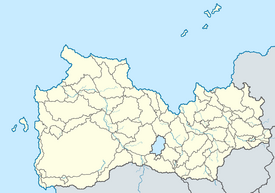User:Pricey/Sandbox3
Eryksborg
| |
|---|---|
 Clockwise from top-left: Amundsby • Eryksborg Clocktower • Church of the Holy Synod overlooking the Kop Inlet • North bastion of Eryksborg Castle | |
| Etymology: "Erik's city", "City [of] Erik" | |
Location within Soravia | |
| Country | |
| Province | Ludoy Islands |
| Founded | 851 AD |
| Founded by | Erik Ansgarson |
| Government | |
| • Body | Miskrada (City Council) |
| • Mayor | Alexey Zorin (PF) |
| Area | |
| • Total | 71.96 km2 (27.78 sq mi) |
| • Water | 5.88 km2 (2.27 sq mi) |
| Elevation | 5 m (16 ft) |
| Population (2021 est.) | |
| • Total | 60,144 (−2.5%) |
| • Census | 61,718 |
| Time zone | UTC-3 (Western Euclean Time) |
| General Postal Code(s) | 1200176–1200186 |
Eryksborg (Soravian: Ериксборг; IPA: [ɛrɪksʲ'boˈrg], Kirenian: Eeriksbuuri), also known briefly as Ivanske (Soravian: Іванське; IPA: [ivɐnsk] is a small city and velvolost on the island of Velyka Ludoya in the Perovo Sea. It is the most populous and the capital city of the Ludoy Islands. Its cityscapes include some of the most well-preserved medieval architecture in Soravia, including Eryksborg Castle and Kupaske Stave Church, and its architecture has been invariably shaped by intermittent Ejderic, Sadamic and Soravian rule.
According to legend, the city was founded by Erik Ansgarson in 851 to be the primary fishing town for his detachment of men sailing the Perovo. Eleanora of Caldia's Uí Mealla clan briefly held the city, but after the execution of Flaithbertach Uí Mealla by Moimir the Kneebringer's armies of Pavatria, the city fell back under Ejderic control. After the fall of the First North Sea Empire and its various successor states, the city became de facto governed by its mercantile elite, who operated in the form of an early guild or confraternity. The city, whose sovereignty became threatened by Pavatrian expansion, joined the Maritime Guild in 1228. The Guild's navy protected the city from invasion, and in turn the city provided it with near complete control over trade in the Perovo.
